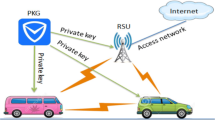Abstract
Deniable ring authentication can be used to facilitate privacy-preserving communication since the receiver accepts authentication while cannot convince a third party that the fact of this authentication occurred. Besides that, the receiver cannot decide the actual sender as the sender identity is hidden among a group of participants. However, the concurrent problem has not been studied well in the interactive deniable ring authentication so far. In this work, we propose a deniable ring authentication protocol to handle concurrent scenario, which achieves full deniability. We construct a CCA2-secure (which is secure against Adaptive Chosen Ciphertext attack) multi-receiver encryption scheme to support this protocol and it requires only 2 communication rounds, which is round-optimal in fully deniable ring authentications. In addition, we observe that efficient fully deniable ring authentication can be applied to location-based service in VANETs to protect vehicle privacy.



Similar content being viewed by others
References
Bellare M., Boldyreva A., Micali S. (2000) Public-key encryption in a multi-user setting: security proofs and improvements. In: Eurocrypt, LNCS 1807, pp 259–274
Bellare M., Canetti R., Krawczyk H. (1998) A modular approach to the design and analysis of authentication and key exchange protocols. In: STOC, pp 419–428
Bellare M., Palacio A. (2004) Towards plaintext-aware public-key encryption without random oracles. In: Asiacrypt, LNCS 3329, pp 48–62
Damgard I. (1992) Towards practical public key systems secure against chosen ciphertext attacks. In: Crypto, LNCS 576, pp 445–456
Di Raimondo M., Gennaro R. (2005) New approaches for deniable authentication. In: CCS, pp 112–121
Di Raimondo M., Gennaro R. (2009) New approaches for deniable authentication. J. Cryptol. 22:572–615
Di Raimondo M., Gennaro R., Krawczyk H. (2006) Deniable authentication and key exchange. In: CCS, pp 400– 409
Dolev D., Dwork C., Naor M. (2000) Non-malleable cryptography. SIAM J. Comput. 30(2):391–437
Dowsley R., Hanaoka G., Imai H., Nascimento A.C.A. (2011) Round-optimal deniable ring authentication in the presence of big brother. In: WISA, LNCS 6513, pp 307–321
Du S., Zhu H., Li X., Ota K., Dong M. (2013) MixZone in motion: achieving dynamically cooperative location privacy protection in delay-tolerant networks. IEEE Trans. Veh. Technol. 62(9):4565–4575
Dwork C., Naor M., Sahai A. (1998) Concurrent zero-knowledge. In: STOC, pp 409–418
Dwork C., Naor M., Sahai A. (2004) Concurrent zero-knowledge. J. ACM 51(6):851–898
Fei N., Zhuang Y., Gu J., Cao J., Yang L. (2015) Privacy-preserving relative location based services for mobile users. Commun. China 12(5):152–161
Freier A.O., Karlton P., Kocher P.C. The SSL protocol, version 3.0, Internet draft (Nov. 1996), http://dreaft-freier-ssl-version3-02.txt
Gu L., Pan Y., Dong M., Ota K. (2013) Noncommutative lightweight signcryption for wireless sensor networks. In: IJDSN 2013
Jiang S., Safavi-Naini R. (2008) An efficient fully deniable key exchange protocol. In: FC, LNCS 5143, pp 47–52
Krawczyk H. (1996) SKEME, a versatile secure key exchange mechanism for Internet. In: NDSS, pp 114–127
Krawczyk H., Rabin T. (2000) Chameleon hashing and signautres. In: NDSS, pp 143–154
Li F., Xiong P., Jin C. (2014) Identity-based deniable authentication for ad hoc networks. Computing 96:843–853
Li H., Dai Y., Tian L., Yang H. (2009) Identity-based authentication for cloud computing. In: CloudCom, LNCS 5931, pp 157–166
Naor M. (2002) Deniable ring authentication. In: Crypto, LNCS 2442, pp 481–498
Oh Y., Jung K., Park S. (2014) A privacy preserving technique to prevent sensitive behavior exposure in semantic location-based service. Proced. Comput. Sci. 35:318–327
Ota K., Dong M., Zhu H., Chang S., Shen X. (2011) Traffic information prediction in Urban Vehicular Networks: A correlation based approach. In: WCNC 2011, pp 1021–1025
Ota K., Dong M, Chang S., Zhu H. (2015) MMCD: Cooperative downloading for highway VANETs. IEEE Trans. Emerg. Top. Comput. 3(1):34–43
Pass R. (2003) On deniability in the common reference string and random oracle model. In: Crypto, LNCS 2729, pp 316–337
Pingley A., Yu W., Zhang N., et al. (2012) A context-aware scheme for privacy-preserving location-based service. Comput. Netw. 56(1):2551–2568
Susilo W., Mu Y. (2004) Non-interactive deniable ring authentication. In: ICISC, LNCS 2971, pp 386–401
Susilo W., Mu Y. (2004) Deniable ring authentication revistied. In: ACNS, LNCS 3089, pp 149–163
Wang L., Zhang G., Ma C. (2008) Id-based deniable ring authentication with constant-size signature. Front. Comput. Sci. China 2(1):106–112
Wasef A., Shen X. (2010) REP: Location privacy for VANETs using random encryption periods. Mobile Networks Applications 15(1):172–185
Author information
Authors and Affiliations
Corresponding author
Additional information
This work is supported by the National Natural Science Foundation of China (61402376, U1433130), the Open Research Subject of Key Laboratory of Digital Space Security (szjj2014-078) and the Scientific Research Funds Project of Science and Technology Department of Sichuan Province (2016JY0244).
Rights and permissions
About this article
Cite this article
Zeng, S., Chen, Y., Tan, S. et al. Concurrently deniable ring authentication and its application to LBS in VANETs. Peer-to-Peer Netw. Appl. 10, 844–856 (2017). https://doi.org/10.1007/s12083-016-0433-8
Received:
Accepted:
Published:
Issue Date:
DOI: https://doi.org/10.1007/s12083-016-0433-8




